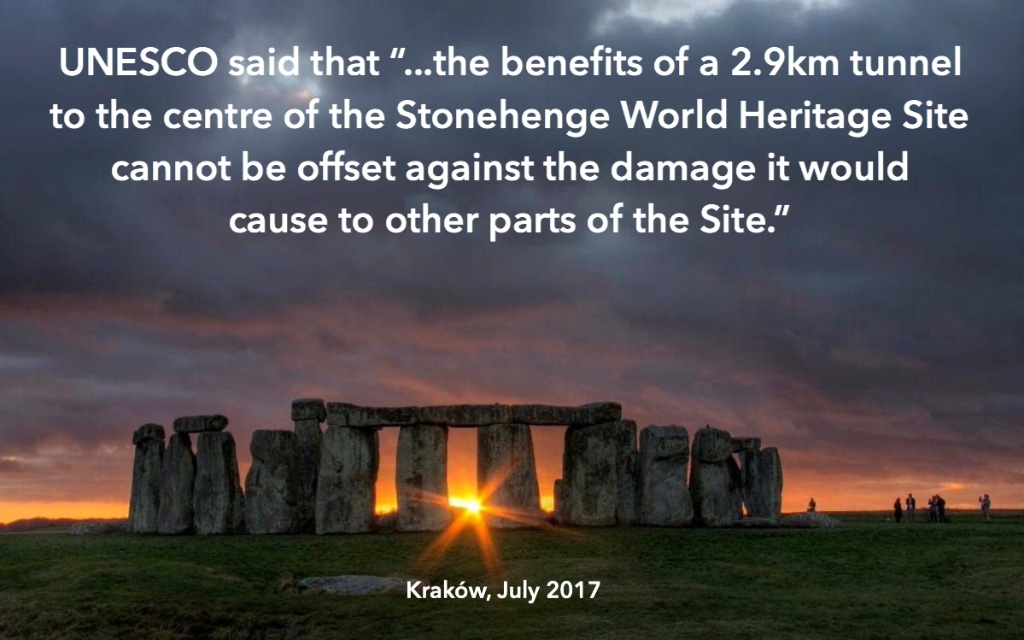Busting the Mythbusters!
 A ‘mythbusting’ item has been published by English Heritage as part of a joint press release on behalf of English Heritage, National Trust and Historic England. We reproduce these ‘mythbusters’ with our responses beneath.
A ‘mythbusting’ item has been published by English Heritage as part of a joint press release on behalf of English Heritage, National Trust and Historic England. We reproduce these ‘mythbusters’ with our responses beneath.
PLEASE NOTE 6 August 2020: We note that since publishing the link to English Heritage’s page above their mythbusters item the item has been removed. We have pasted the original copy below.
- English Heritage says: The proposed tunnel won’t run under Stonehenge. The current proposals are for a 2.9km tunnel to run about 600m to the south of the current A303 surface road. The stability of the stones will not be affected at all.
The Alliance says: The Stones stand within c.10 sq.mls of a c.5.4km-wide UNESCO World Heritage Site (WHS). UNESCO has advised the Government to seek alternative road solutions to avoid damaging the WHS. Geotechnical survey work is incomplete: ground stability may be an issue.
- English Heritage says: A tunnel won’t remove the stones from sight. Removing the busy and noisy road means that there will be more opportunities for people to get out of their cars and explore the world heritage landscape that has for years been severed by the road.
The Alliance says: Several generations of motorists and passengers value the view of the Stone monument from the A303: this would be lost. Most visitors would have to pay to see the Stones. Footpaths and byways would be fenced. Much of the WHS is private land.
- English Heritage says: There is no evidence that the proposed tunnel will damage the Mesolithic site of Blick Mead. The proposed tunnel and any infrastructure needed to improve the Countess roundabout are well away from the site (Blick Mead is 700m away from the roundabout). Highways England is aware of the water table issues and will be assessing any potential impact on the site.
The Alliance Says: The extent of Blick Mead is unknown and needs further investigation. A massive flyover would pass alongside and possibly over part of the site; it would also impact on a Grade I Listed house, its Registered park, and a Conservation Area. Water table issues are still uncertain.
- English Heritage says: It’s not a ‘done deal’. There’s still work to be done on the tunnel proposals, and the scheme is likely to change, on the basis of feedback from the current consultation process. Later this year, Highways England will make their application for a Development Consent Order (DCO) – a special type of planning permission for nationally significant infrastructure projects.
The Alliance says: The Government is committed to a short tunnel in the WHS. The consultation process assumes that the scheme is a ‘done deal’ since objections to it will apparently not be considered. Consultation is being undertaken without full information available. [In the event the Examining Authority recommended against the scheme].
- English Heritage says: Doing nothing isn’t an option. The A303 past Stonehenge regularly carries 24,000 vehicles, nearly twice as much traffic as it was designed for, and on a summer weekend that figure leaps to 29,000. The result is severe congestion which compromises the WHS. It also causes delays, affecting local communities, commuters and visitors to Wiltshire. With around 120,000 new jobs and 100,000 new homes expected across the South West by 2021, and even greater growth after that, the A303 will get busier still.
The Alliance says: Doing nothing would be better than trashing a WHS. But measures could be taken now to stop rat running and reduce congestion. There is far worse regular congestion in towns and cities in the South West. Road widening induces more traffic, placing strain on adjoining roads. New technology may revolutionise transport over the next 20–30 years, making road widening unnecessary.
Highways England’s consultation runs until 6th April. Details of the scheme can be seen here. The consultation booklet here and the official consultation response form here.
Check out our website, Facebook and Twitter for more about the scheme. We have made some initial non technical suggestions here for responding to the consultation. We will publish a fuller response after we have had time to study the documentation.
Please share

